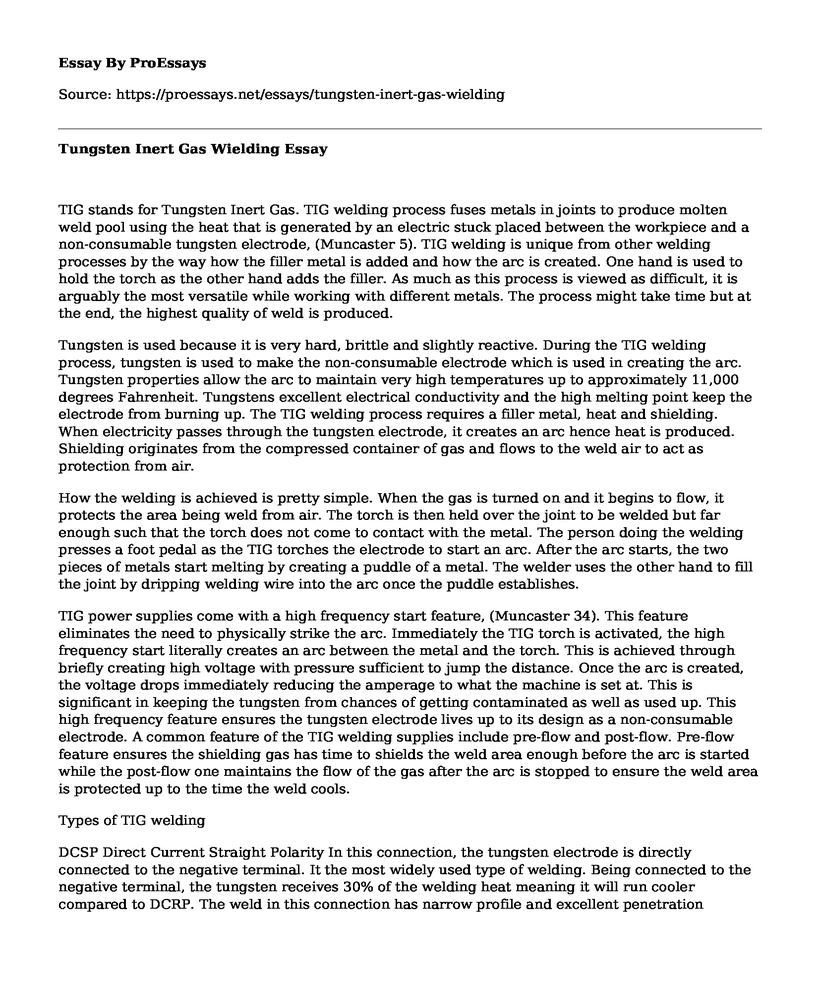TIG stands for Tungsten Inert Gas. TIG welding process fuses metals in joints to produce molten weld pool using the heat that is generated by an electric stuck placed between the workpiece and a non-consumable tungsten electrode, (Muncaster 5). TIG welding is unique from other welding processes by the way how the filler metal is added and how the arc is created. One hand is used to hold the torch as the other hand adds the filler. As much as this process is viewed as difficult, it is arguably the most versatile while working with different metals. The process might take time but at the end, the highest quality of weld is produced.
Tungsten is used because it is very hard, brittle and slightly reactive. During the TIG welding process, tungsten is used to make the non-consumable electrode which is used in creating the arc. Tungsten properties allow the arc to maintain very high temperatures up to approximately 11,000 degrees Fahrenheit. Tungstens excellent electrical conductivity and the high melting point keep the electrode from burning up. The TIG welding process requires a filler metal, heat and shielding. When electricity passes through the tungsten electrode, it creates an arc hence heat is produced. Shielding originates from the compressed container of gas and flows to the weld air to act as protection from air.
How the welding is achieved is pretty simple. When the gas is turned on and it begins to flow, it protects the area being weld from air. The torch is then held over the joint to be welded but far enough such that the torch does not come to contact with the metal. The person doing the welding presses a foot pedal as the TIG torches the electrode to start an arc. After the arc starts, the two pieces of metals start melting by creating a puddle of a metal. The welder uses the other hand to fill the joint by dripping welding wire into the arc once the puddle establishes.
TIG power supplies come with a high frequency start feature, (Muncaster 34). This feature eliminates the need to physically strike the arc. Immediately the TIG torch is activated, the high frequency start literally creates an arc between the metal and the torch. This is achieved through briefly creating high voltage with pressure sufficient to jump the distance. Once the arc is created, the voltage drops immediately reducing the amperage to what the machine is set at. This is significant in keeping the tungsten from chances of getting contaminated as well as used up. This high frequency feature ensures the tungsten electrode lives up to its design as a non-consumable electrode. A common feature of the TIG welding supplies include pre-flow and post-flow. Pre-flow feature ensures the shielding gas has time to shields the weld area enough before the arc is started while the post-flow one maintains the flow of the gas after the arc is stopped to ensure the weld area is protected up to the time the weld cools.
Types of TIG welding
DCSP Direct Current Straight Polarity In this connection, the tungsten electrode is directly connected to the negative terminal. It the most widely used type of welding. Being connected to the negative terminal, the tungsten receives 30% of the welding heat meaning it will run cooler compared to DCRP. The weld in this connection has narrow profile and excellent penetration
DCRP Direct Current Reverse Polarity Tungsten electrode is connected direct to the positive terminal. This type of welding is rare as most heat is on tungsten resulting in it overheating and burning away. This welding produces wide, shallow profile useful on light material at relatively low amps.
AC Alternating current This type of welding is mostly preferred for white metals for example magnesium and aluminum. Heat on tungsten is relatively low since the AC wave passes from one side to the other.
AC Alternating Current Square Wave Advancement in modern electricity enables production of AC welding machines with a wave form called Square Wave. This has more control and either side of the wave is controlled to have a more cleaning half of the cycle
Application
TIG welding is currently widely used in many industries due to the high quality and low-cost of welds it produces, (Lucas 97). Aerospace and nuclear industries use TIG welding in repair and maintenance works because it flexible and easy to control. The manual TIG welding technique is applied in automatic, semiautomatic and machine welding as well as spot welding. Making quality fabrications in stainless steel and alloys of aluminum, nickel and copper applies TIG welding. Orbital TIG welding is used in pharmaceutical, semi-conductor, nuclear and food industries for pipework installations, (Lucas 46).
Works cited
Lucas, W. Tig and Plasma Welding: Process Techniques, Recommended Practices and Applications. Cambridge, England: Abington, 1990. Print.
Muncaster, Peter. Practical Tig (gta) Welding. Abington, 1991. Print.
Cite this page
Tungsten Inert Gas Wielding. (2021, Mar 06). Retrieved from https://proessays.net/essays/tungsten-inert-gas-wielding
If you are the original author of this essay and no longer wish to have it published on the ProEssays website, please click below to request its removal:
- Essay Sample on Employment Trends and Opportunities in the Nuclear Industry
- Artificial Intelligence Essay Sample
- Research Paper on Grassroots International Hospital
- Essay Example on Kuwait: World's Largest Oil Exporter and Its Trade Partners
- Essay on Soar Through the Skies: A Guide to Gliders & Motor-Gliders
- Essay Example on Maintaining Constant Fission Reaction in Nuclear Reactor Systems
- Essay on Personality Traits & Problematic Internet/Smartphone Use







